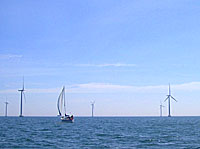The United States now has a new source of clean electricity for homes, buildings, and industrial stationary power and also for the growing use of electricity in rail and electric cars. Wind power is especially available at night when we hope to eventually charge millions of vehicles.
Global wind energy capacity is increasing by 160% over the coming five years from 155 GW to 409 GW, according to the annual industry forecast presented by the Global Wind Energy Council (GWEC). A growing part of the renewable energy (RE) mix is off-shore wind, popular in Europe for 20 years, but stopped in the U.S. by not-in-my-backyard opposition, or more accurately “not in the view of my expensive ocean front property.”
Secretary of the Interior Ken Salazar showed political courage on April 28 by approving the Cape Wind renewable energy project on federal submerged lands in Nantucket Sound. He will require the developer of the $1 billion wind farm to agree to additional binding measures to minimize the potential adverse impacts of construction and operation of the facility. Salazar said,” With this decision we are beginning a new direction in our Nation’s energy future, ushering in America’s first offshore wind energy facility and opening a new chapter in the history of this region.”
The project is a big win for Siemens who will supply 130 3.6 MW towers, outbidding GE, Vestas, and other competitors. Siemens has already sold over 1,000 of these large off-shore turbines. The Cape Wind facility will generate a maximum electric output of 468 megawatts with an average anticipated output of 182 megawatts. At average expected production, Cape Wind could produce enough energy to power more than 200,000 homes in Massachusetts, or charge 200,000 electric cars.
One-fifth of the offshore wind energy potential of the East Coast is located off the New England coast and Nantucket Sound receives strong, steady Atlantic winds year round. The project includes a 66.5-mile buried submarine transmission cable system, an electric service platform and two 115-kilovolt lines connecting to the mainland power grid. The project would create several hundred construction jobs and be one of the largest greenhouse gas reduction initiatives in the nation, cutting carbon dioxide emissions from conventional power plants by 700,000 tons annually.
Over one GW of off-shore wind is proposed for other Eastern coastal states, eager to catch-up with the renewable energy use of Western and Central states. For example, due to California’s abundance of wind, solar, and geothermal power, my California utility does not use coal.
To overcome years of opposition, the number of turbines at Cape Wind has been reduced from 170 to 130, minimizing the visibility of turbines from the Kennedy Compound National Historic Landmark; reconfiguring the array to move it farther away from Nantucket Island; and reducing its breadth to mitigate visibility from the Nantucket Historic District. Translation is that from shore it will take Superman vision to notice the wind turbines 5.2 miles from the mainland shoreline, 13.8 miles from Nantucket Island and 9 miles from Martha’s Vineyard.
A number of tall structures, including broadcast towers, cellular base station towers, local public safety communications towers and towers for industrial and business uses are already located around the area. Three submarine transmission cable systems already traverse the seabed to connect mainland energy sources to Martha’s Vineyard and Nantucket Island.
“After almost a decade of exhaustive study and analyses, I believe that this undertaking can be developed responsibly and with consideration to the historic and cultural resources in the project area,” Salazar said. “Impacts to the historic properties can and will be minimized and mitigated and we will ensure that cultural resources will not be harmed or destroyed during the construction, maintenance, and decommissioning of the project.”
Renewable Energy Reports and Articles


Offshore wind power is a relatively new technology. The sector had an initial base of only 35 MW in 2000. However there have been improvements in this technology. Offshore wind turbines are being used in a number of countries to harness the energy of wind. Offshore winds tend to flow at higher speeds than onshore winds, thus allowing turbines to produce more electricity. Transformer company Pacific Crest Transformers, offers custom built energy-efficient transformers for the wind energy sector. It has interesting case studies on the renewable energy market. Visit their website for more information.
I believe there is always an appropriate place for wind turbines and safety precautions can always be implemented. We just need to realize that we really need to get rid of the polluting sources of energy. Although we understand that the oil companies are doing their best not to be out of business even if knowing the ill effects of the burning of fossil fuel.